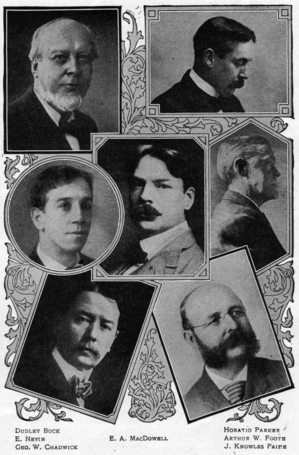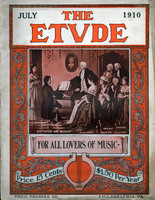 (From “The Young Folks’ Standard History of Music”)
(From “The Young Folks’ Standard History of Music”)
[Musical History is really an extremely interesting subject when the matter is presented in a thoroughly understandable manner. The object of the work of which the following is one of forty story lessons is to make the subject of musical history accessible to the beginner and at the same time inviting and inspiring. The work is designed for adults as well as young people, the only distinction being its simplicity and popular style.]
When the Puritans came to America in 1620 music in Europe was really quite advanced, although Bach and Handel were not born until sixty-five years later. At first the strict religious beliefs of the Puritans limited the music of the colonies to Psalm tunes, but about one hundred years later (1717) we find singing schools and choirs springing into existence. About the middle of the eighteenth century the interest in music greatly increased and WILLIAM BILLINGS (born in Boston, 1746) has the reputation of being the first American composer of renown. His compositions were very crude, however, and woefully behind those of the leading musicians in Europe at that time, since they were of necessity limited to hymn tunes and bungling musical settings of religious texts.
In the last part of the eighteenth century musical societies were formed, the most noted being the “Stoughton (Mass.) Musical Society,” which had grown from a singing class formed by Billings in 1774, and the “Handel and Haydn Society,” formed in Boston in 1815. Soon thereafter musical and orchestral societies sprang into existence in New York, Philadelphia and other cities, and it is somewhat surprising to learn that Beethoven’s first symphony was performd (sic) by the Musical Fund Society in Philadelphia as early as 1821. Opera had been given in New Orleans, New York, and in Philadelphia still earlier. In 1825 Manuel Garcia brought an excellent opera company to New York, which included his daughter, MME. MALIBRAN, and his son, MANUEL GARCIA, JR., who became one of the world’s most famous singing teachers, and lived to an age of 102.
One of the greatest forces in early American musical history was LOWELL MASON (born at Medfield, Mass., 1792; d., 1872), who although almost entirely self-taught did more for the advancement of music in America than any other musician of his time. As a young man he conducted choirs in Medfield and at Savannah. In 1827 he became president of the Handel and Haydn Society of Boston, and ten years later he went abroad to study musical teaching methods. He published many popular collections of music for the home and choir, which brought him a very large income. The excellent work of his son William has been so widely discussed that mention here is not necessary.
THEODORE THOMAS (born at Esens, Germany, 1835; died, 1905) following Dr. Lowell Mason, was a very powerful factor in the development of music in America. He studied the violin with his father and played in public at the age of six. At the age of ten he came to America and made important tours of the country as a violin virtuoso. Thomas conducted different orchestras at different times in New York and Cincinnati, and latter became conductor of the famous Chicago Orchestra, which after his death was named the “Thomas Orchestra.” Thomas was very advanced in his views, and the excellence of his programs won him fame in Europe.
DR. LEOPOLD DAMROSCH (born in Rosen, 1832; died in 1885), at first a physician and later an able violinist and conductor, came to America in 1871. He had been an intimate friend of Liszt and Wagner, and his services in introducing the works of modern masters in America cannot be overestimated. This work has been ably continued by his sons, WALTER DAMROSCH and FRANK DAMROSCH.
JOHN KNOWLES PAINE (b., Portland, Maine, 1839; died in 1906) was one of the first American musicians to show the results of thorough European schooling. He studied with Kotschmar at Portland and with Haupt, Fischer and Wieprecht at Berlin. He was an exceptionally fine organist, and played with success in Europe and in America. In 1876 he became Professor of Music at Harvard, and held this position until his death. His works, which include two symphonies, two symphonic poems, an oratorio, a mass and other notable compositions, are scholarly and dignified yet show deep musical feeling.
DUDLEY BUCK (b. Hartford, Conn., 1839), pupil of Plaidy, Moscheles Hauptmann, J. Rietz in Leipsic, and later of Schneider in Dresden, stands with J. K. Paine and William Mason as one of the pioneers of advanced musical work in America. He was »a very excellent organist, and after his return to America he continually held fine organ positions in many of the representative churches of the country. For a time he was assistant conductor to Theo. Thomas. His compositions have been exceptionally popular, and possibly have sold more than those of any other American composer with serious intentions. They include much excellent organ music, many fine cantatas and numerous exceedingly popular works for the church choir. All of his music shows his natural genius and his sensitive, intensely musical nature.
BENJAMIN J. LANG (b., Salem, Mass., 1837; d., 1909) also had the advantage of European study in the day when European study was a necessity. He was a pupil of his father, of Alfred Jaell and of Franz Liszt. In addition to being an able organist, he was also a very fine pianist and a most excellent teacher. He settled in Boston, and was the conductor of many important societies, including the “Handel and Haydn Society.” His compositions include symphonies, overtures, an oratorio and much church music.
The more modern composers in America have not attempted to found an American school differing widely from the music of the European masters, but have tried to create works which will rank with the best of European composers. There seems to be a little difference of opinion among critics in placing Edward MacDowell at the very head of American composers of recent years.
EDWARD MacDOWELL (b., New York, 1861; d., 1908) was a pupil of Teresa Carreño, J. Buitrago and P. Desvernine in New York; Marmontel and Savard at the Paris Conservatory, and Heymann and Raff at Frankfurt. In 1881-1882 he was the head teacher of pianoforte in the Darmstadt (Germany) Conservatory. For some time he lived in Wiesbaden (Germany) and in Boston, but in 1896 he was appointed Professor of Music at Columbia University, New York. He made several concert tours, and revealed himself as a virtuoso of the highest type. His compositions are strikingly original, full of deep musical feeling and character, and show very comprehensive knowledge of the technic of musical composition. They include almost all forms and have met with wide appreciation, notwithstanding their lofty musical style, Owing to worry and overwork, MacDowell suffered from a mental trouble in later years which made death a blessing.
GEORGE WHITFIELD CHADWICK (b., Lowell, Mass., 1854) was a pupil of Eugene Thayer in Boston; Reinecke and Jadassohn in Leipsic, and Rheinberger in Munich, For many years he has been a successful organist in Boston and has been director of the New England Conservatory of Music since 1897. His compositions for orchestra, church and the voice all show strength and musical skill combined with decided talent.
HORATIO W. PARKER (b., Auburndale, Mass., 1863) was a pupil of Stephen Emery, J. Orth and G. Chadwick at Boston, and of Rheinberger and Abel in Munich. Parker is an able organist and choirmaster, and has held some of the most desirable church positions in America, but he is best known as Professor of Music at Yale University, a position which he has held since 1894, and as a composer. His works, which embrace oratorios, cantatas, a symphony, worthy organ compositions and excellent songs show breadth and finished musicianship. His oratorio, “Hora Novissima,” which was given at an important festival at Worcester, England, was one of the first large compositions of an American to attract attention in Europe.
ARTHUR W. FOOTE (b., Salem, Mass., 1853) has received his musical education entirely in America. He is a pupil of Lang, Emery and Paine in Boston. His works show a natural ability to create beautiful melodies, and indicate that in finish and thoroughness he has lost nothing by failing to go abroad. His orchestral pieces, cantatas, songs and piano compositions are fascinating and often powerful.
ETHELBERT W. NEVIN (b., Edgeworth, Pa., 1862; d., 1901), one of the most melodious and artistic of all American composers, confined himself almost entirely to the shorter forms and rarely attempted to produce scholarly or deep musical works; nevertheless, his very great talent and originality, as well as his fine taste, places him at the head of the American song writers. His pieces, such as the famous “Narcissus” and the “Barchetta,” from “May in Tuscany,” have sold enormously. He was a pupil of Heide and Gunther in Pittsburg; Pearce, Lang and Emery in Boston; Boehme in Dresden, and Von Bülow, Klindworth and Bial in Berlin.
MRS. H. H. A. BEACH (b, Henniker, N. H., 1867), although a piano pupil of Perabo and Baermann and a harmony pupil of J. W. Hill, is almost entirely self-taught in Counterpoint, Composition and Orchestration. Her numerous compositions include symphonies, concertos, cantatas, as well as many exceedingly beautiful pieces in smaller form. Mrs. Beach’s works all show lofty ambitions and musical talent of masterly character. Her symphonies have been performed by the Boston Symphony Orchestra with great success.
WILLIAM W. GILCHRIST (b., Jersey City, 1846) is a pupil of Dr. Hugh A. Clarke, of the University of Pennsylvania. He has held important posts as organist and has written choral and church music, as well as songs of a very high order.
No account of American music would be complete without some mention of STEPHEN C. FOSTER (b., Lawrenceville, Pa., 1826; d., 1864), who, although self-taught, has the wonderful power of writing truly beautiful melodies, which have been so much sung by the American people that they have reached the rank of folk songs. They include “The Old Folks at Home,” “My Old Kentucky Home” and “Old Black Joe.”
The works of some other American composers have been immensely popular with the people. Among them we may mention JOHN PHILIP SOUSA (b., Washington, D. C., 1856), famous as a bandmaster and the author of marches that have been played more than the works of any other American composer; REGINALD de KOVEN (b., Middletown, Conn., 1859), composer of many successful operas.
The limitations of space prevent our giving detailed biographies of such worthy American composers as JAMES H. ROGERS, HARRY ROWE SHELLEY, E. R. KROEGER, EMIL LIEBLING, H. W. LOOMIS, H. H. HUTT, MARGARET R. LANG, R. de KOVEN, WILSON G. SMITH, ARTHUR FARWELL, RUBIN GOLDMARK, R. H. WOODMAN, WHITNEY COOMBS and many others.



